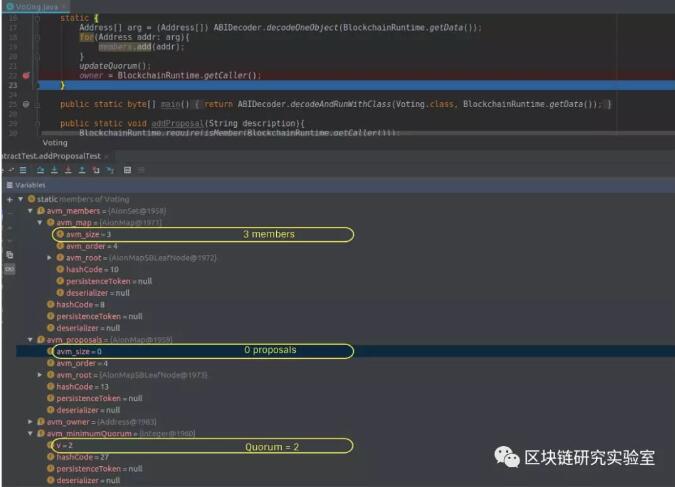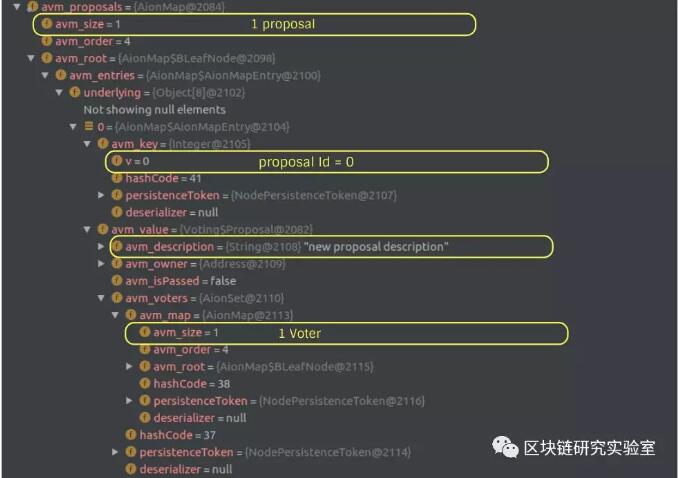Java开发的智能合约单元测试教程
在本教程中,我们将实现一个简单的合约,为其编写单元测试,并运行调试过程以查找Bug。
运行该示例所需的全部是Java和IDE。 只需创建一个依赖AVM最新工具库的Java项目作为库。
1.编写智能合约
首先创建智能合约。以下是可用于简单投票DApp的智能合约的示例。
智能合约的功能:
1. 只有合约所有者(部署合约的帐户)可以添加或删除成员。
2. 只有会员可以介绍新的提案。
3. 只有会员可以对提案进行投票。
4. 如果超过50%的成员赞成该提案并对其投票,该提案将通过。
package org.aion.avm.embed.temp;
import avm.Blockchain;
import org.aion.avm.tooling.abi.Callable;
import org.aion.avm.userlib.AionMap;
import org.aion.avm.userlib.AionSet;
import avm.Address;
import org.aion.avm.userlib.abi.ABIDecoder;
public class Voting {
private static AionSet<Address> members = new AionSet<>();
private static AionMap<Integer,
Proposal> proposals = new AionMap<>();
private static Address owner;
private static int minimumQuorum;
static {
ABIDecoder decoder = new ABIDecoder(Blockchain.getData());
Address[] arg = decoder.decodeOneAddressArray();
for (Address addr : arg) {
members.add(addr);
}
updateQuorum();
owner = Blockchain.getCaller();
}
@Callable
public static void addProposal(String description) {
Address caller = Blockchain.getCaller();
Blockchain.require(isMember(caller));
Proposal proposal = new Proposal(description, caller);
int proposalId = proposals.size();
proposals.put(proposalId, proposal);
Blockchain.log(“NewProposalAdded”.getBytes(),
Integer.toString(proposalId).getBytes(), caller.toByteArray(),
description.getBytes());
}
@Callable
public static void vote(int proposalId) {
Address caller = Blockchain.getCaller();
Blockchain.require(isMember(caller) && proposals.containsKey(
proposalId));
Proposal votedProposal = proposals.get(proposalId);
votedProposal.voters.add(caller);
Blockchain.log(“Voted”.getBytes(),
Integer.toString(proposalId).getBytes(), caller.toByteArray());
if (!votedProposal.isPassed && votedProposal.voters.size() ==
minimumQuorum) {
votedProposal.isPassed = true;
Blockchain.log(“ProposalPassed”.getBytes(),
Integer.toString(proposalId).getBytes());
}
}
@Callable
public static void addMember(Address newMember) {
onlyOwner();
members.add(newMember);
updateQuorum();
Blockchain.log(“MemberAdded”.getBytes(),
newMember.toByteArray());
}
@Callable
public static void removeMember(Address member) {
onlyOwner();
members.remove(member);
updateQuorum();
Blockchain.log(“MemberRemoved”.getBytes(),
member.toByteArray());
}
@Callable
public static String getProposalDescription(int proposalId) {
return proposals.containsKey(proposalId) ?
proposals.get(proposalId).description : null;
}
@Callable
public static Address getProposalOwner(int proposalId) {
return proposals.containsKey(proposalId) ?
proposals.get(proposalId).owner : null;
}
@Callable
public static boolean hasProposalPassed(int proposalId) {
return proposals.containsKey(proposalId) &&
proposals.get(proposalId).isPassed;
}
@Callable
public static int getMinimumQuorum() {
return minimumQuorum;
}
@Callable
public static boolean isMember(Address address) {
return members.contains(address);
}
private static void onlyOwner() {
Blockchain.require(owner.equals(Blockchain.getCaller()));
}
private static void updateQuorum() {
minimumQuorum = members.size() / 2 + 1;
}
private static class Proposal {
String description;
Address owner;
boolean isPassed;
AionSet<Address> voters = new AionSet<>();
Proposal(String description, Address owner) {
this.description = description;
this.owner = owner;
}
}
}
合约中的static块在部署时仅执行一次。 我们在此块中设置初始成员,minimumQuorum和所有者。尽管我们与一组成员启动了合约,但所有者随后也可以添加和删除成员。
我们使用AionSet和AionMap跟踪成员及其提案。可以使用其唯一标识符从地图访问每个建议。
智能合约的主要职能是:
· addProposal,允许成员添加提案说明以进行投票。
· vote,允许成员通过传递其ID对可用提案进行投票。赢得多数成员投票的提案将通过。请注意,将生成ProposalPassed事件以记录已通过投标的ID。
2.编写单元测试
我们将使用AvmRule编写测试。 AvmRule是用于在嵌入式AVM上测试合约的Junit规则。 它创建Aion内核和AVM的内存中表示形式。每次我们运行测试时,都会刷新内置的内核和AVM实例。
在测试我们的合约之前,我们需要将其部署到内存中的Aion 区块链 中,并且我们将使用AvmRule完成此任务。
A.实例化AvmRule
您可以看到该规则包含一个布尔参数,该布尔参数启用/禁用调试模式。 最好在启用调试器的情况下编写测试。您可以在下一部分中查看如何调试合约。
@Rule
public AvmRule avmRule = new AvmRule(true);
注意:此行将为每种测试方法实例化嵌入式AVM。如果将规则定义为@classRule,则将仅为测试类实例化AVM和内核的一个实例。
B.获取合约字节
现在,我们必须获取与合约jar的内存表示相对应的字节。为了获取字节,我们将使用AvmRule中的getDappBytes方法。
getDappBytes采用以下参数:
1. 合约的主要类别。
2. 合约构造函数参数,可以在静态块中对其进行访问和解码。
3. DApp jar中需要包含其他类。
public byte[] getDappBytes(Class<?> mainClass, byte[] arguments,
Class<?>… otherClasses)
C.部署您的智能合约
使用部署功能可以轻松完成智能合约的部署。
public ResultWrapper deploy(Address from, BigInteger value,
byte[] dappBytes)
AvmRule还提供了在Aion内核中创建具有初始余额的帐户的功能。
以下是由3名成员组成的小组部署投票智能合约的方法。
public class VotingContractTest {
@Rule
public AvmRule avmRule = new AvmRule(true);
public Address dappAddress;
public Address owner = avmRule.getPreminedAccount();
public Address[] members = new Address[3];
@Before
public void setup() {
for (int i = 0; i < members.length; i++) {
// create accounts with initial balance
members[i] = avmRule.getRandomAddress(
BigInteger.valueOf(10_000_000L));
}
// encode members array as an argument
byte[] deployArgument = ABIUtil.encodeOneObject(members);
// get the bytes representing the in memory jar
byte[] dappBytes = avmRule.getDappBytes(
Voting.class, deployArgument);
//deploy and get the contract address
dappAddress = avmRule.deploy(
owner, BigInteger.ZERO, dappBytes).getDappAddress();
}
}
D.调用方法
我们可以通过以下方式调用合同中的方法:
1. 编码方法名称及其参数。
2. 将编码后的字节传递给AvmRule的call方法。
public ResultWrapper call(Address from, Address dappAddress,
BigInteger value, byte[] transactionData)
例如我们创建一个新的提案。我们将通过检查是否生成了NewProposalAdded事件以及事件主题和数据正确来验证提案。
@Test
public void addProposalTest() {
String description = “new proposal description”;
byte[] txData = ABIUtil.encodeMethodArguments(
“addProposal”, description);
AvmRule.ResultWrapper result = avmRule.call(
members[0], dappAddress, BigInteger.ZERO, txData);
// assert the transaction was successful
Assert.assertTrue(result.getReceiptStatus().isSuccess());
// assert the event is generated
Assert.assertEquals(1, result.getLogs().size());
Log log = result.getLogs().get(0);
// validate the topics and data
Assert.assertArrayEquals(LogSizeUtils.truncatePadTopic(
“NewProposalAdded”.getBytes()), log.copyOfTopics().get(0));
Assert.assertArrayEquals(LogSizeUtils.truncatePadTopic(
Integer.toString(0).getBytes()), log.copyOfTopics().get(1));
Assert.assertArrayEquals(LogSizeUtils.truncatePadTopic(
members[0].toByteArray()), log.copyOfTopics().get(2));
Assert.assertArrayEquals(description.getBytes(), log.copyOfData());
}
现在我们将提交一个提案以及两个投票。由于有两个不同的成员以ID 0对提案进行了投票,提案应通过。因此我们希望为最后一个事务生成两个不同的事件-Voted和ProposalPassed。
您还可以通过提案ID查询提案的状态。您会看到返回的解码数据为true,表示提案已通过。
@Test
public void voteTest() {
String description = “new proposal description”;
byte[] txData = ABIUtil.encodeMethodArguments(
“addProposal”, description);
AvmRule.ResultWrapper result = avmRule.call(
members[0], dappAddress, BigInteger.ZERO, txData);
Assert.assertTrue(result.getReceiptStatus().isSuccess());
Assert.assertEquals(1, result.getLogs().size());
//vote #1
txData = ABIUtil.encodeMethodArguments(“vote”, 0);
result = avmRule.call(
members[1], dappAddress, BigInteger.ZERO, txData);
Assert.assertTrue(result.getReceiptStatus().isSuccess());
Assert.assertEquals(1, result.getLogs().size());
//vote #2
txData = ABIUtil.encodeMethodArguments(“vote”, 0);
result = avmRule.call(
members[2], dappAddress, BigInteger.ZERO, txData);
Assert.assertTrue(result.getReceiptStatus().isSuccess());
Assert.assertEquals(2, result.getLogs().size());
//validate that the proposal is stored as passed
txData = ABIUtil.encodeMethodArguments(“hasProposalPassed”, 0);
result = avmRule.call(
members[2], dappAddress, BigInteger.ZERO, txData);
//decode the return data as boolean
Assert.assertTrue((boolean) result.getDecodedReturnData());
}
3.调试智能合约
调试我们的智能合约非常容易,只需在源代码中设置断点即可!由于我们在启用调试的情况下创建了AvmRule,因此在达到断点时将停止执行。让我们来看一个例子。
这是部署后智能合约的状态。

您可以看到该智能合约具有:
1. 3名成员。
2. 0个提案。
3. minimumQuorum = 2。
您也可以检查每个集合的内容。例如通过调用addProposal,您将能够看到更新的AionMap。
让我们实际对调试器进行测试。我们将故意在评估提案通过方式时造成一个简单的错误。我将修改提案通过条件,如下所示。 请注意,等于条件已更改为小于或等于。
if (!votedProposal.isPassed && votedProposal.voters.size()
<= minimumQuorum)
现在当第一个所有者提交投票时,提案将通过。
让我们调试方法调用并逐步执行该函数。

您可以看到,尽管minimumQuorum等于2,但是该提案的投票者计数仅为1。我们修改了if语句(来自上面),并且第51行的isPassed标志设置为true。
从那里,您可以轻松地确定错误在代码中的位置。
结论
如果您曾经为 以太坊 开发过智能合约,就会知道用一种陌生的专用语言编写合约并对其进行调试的痛苦。
任何熟悉Java的人都会感觉像在家中一样使用AVM编写智能合约。另外市场上任何IDE中的所有调试功能都可用于测试和调试Java智能合约。
根据国家《 关于防范代币发行融资风险的公告 》,大家应警惕代币发行融资与交易的风险隐患。
本文来自 LIANYI 转载,不代表链一财经立场,转载请联系原作者。











![[HBLOG]公众号](https://www.liuhaihua.cn/img/qrcode_gzh.jpg)

